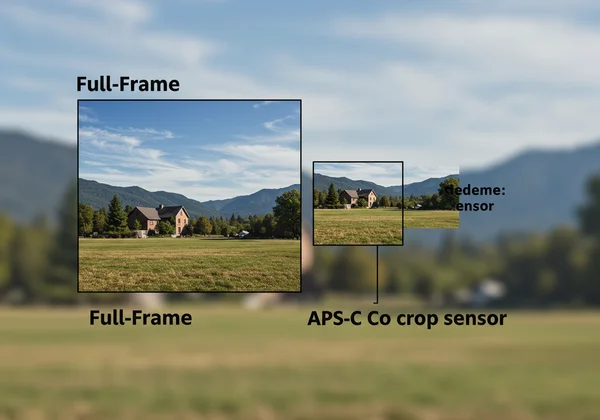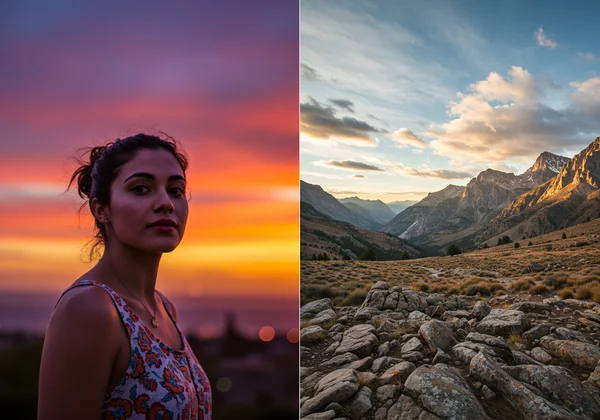Mastering Depth of Field: Full-Frame vs. Crop Sensor with Our DOF Calculator Guide
Ever wonder why a full-frame camera creates dreamy, blurred backgrounds more easily than your APS-C camera? Confused by terms like "crop factor" and "equivalent focal length"? This guide demystifies how camera sensor size impacts your ability to control depth of field (DOF), helping you achieve your photographic vision.
We'll compare full-frame and crop sensors, explain the physics, and show you how to master your craft. Whether chasing creamy bokeh or expansive sharpness, understanding this relationship is key. With a powerful DOF calculator, you can plan your shots with precision before you even pick up your camera.
Understanding Depth of Field & Camera Sensor Basics
Before comparing sensors, let's cover the core concepts. Depth of field isn't random; it's a predictable outcome of physics. Your camera's sensor size is a critical piece of that puzzle, directly influencing the final look of your images.
What Exactly is Depth of Field (DOF) in Photography?
Depth of field (DOF) is the zone in a photo that appears acceptably sharp, extending in front of and behind your focus point. A "shallow depth of field" means only a narrow slice is in focus, creating the blurry backgrounds common in portraits. Conversely, a "deep depth of field" keeps a large area sharp, from foreground to background—ideal for landscapes. While aperture, focal length, and subject distance are the main controls, sensor size is a crucial variable that changes the equation.

The Crucial Concept: Circle of Confusion (CoC) Explained
To understand how sensor size affects DOF, we must grasp the Circle of Confusion (CoC). Light converges to a perfect point on the sensor only at the exact plane of focus. Light from objects outside this plane forms tiny circles. If these circles are small enough to be perceived as points, the object appears sharp. The maximum size of this circle before it's seen as a blur is the "Circle of Confusion."
The key is that larger sensors, like full-frame, have a larger acceptable CoC value because the final image is enlarged less for the same size print. This larger CoC is a core reason why sensor format and perceived depth of field are linked. You can explore these values using an online calculator.
Full-Frame vs. Crop Sensor: A Direct Depth of Field Comparison
Now we can tackle the main question: how does a full-frame sensor's DOF differ from a crop sensor's? For this discussion, we'll primarily compare the 35mm "full-frame" standard against the common APS-C "crop sensor" format. The principles, however, apply to other formats like Micro Four Thirds as well.
How Sensor Size Affects Your Perceived Field of View
The most immediate difference between sensors is the "crop factor." A smaller APS-C sensor captures a smaller portion of the image from the lens, making it seem "zoomed in." For instance, a 50mm lens on an APS-C camera (1.5x crop) provides a field of view equivalent to a 75mm lens on a full-frame. This is critical for DOF. To get the same subject framing with an APS-C camera, you must use a wider focal length or stand further back—both actions inherently increase depth of field.

Achieving Shallow Depth of Field: Full-Frame's Advantage
For portraits with blurry backgrounds, a full-frame sensor has a distinct advantage. To frame a person from the waist up with an 85mm lens, you might stand 10 feet away. To get the same framing with an APS-C camera, you'd have to stand 15 feet away or switch to a 56mm lens—both options increase DOF. Consequently, when framing a subject identically, a full-frame system naturally produces a shallower depth of field. This makes full-frame cameras ideal for portrait and wedding photographers who need to isolate subjects from distracting backgrounds. You can easily see this effect with a lens simulator.
Deep Depth of Field: Where Crop Sensors Shine
While full-frame excels at shallow DOF, crop sensors have strengths too. They inherently produce a deeper depth of field for an equivalent field of view, which is advantageous for genres needing maximum sharpness. For landscape photographers, it's easier to keep everything from foreground to background in focus. Macro photographers also benefit from the extra DOF when working at close distances where depth of field becomes razor-thin.

Practical Applications & Using a Crop Sensor Calculator
Theory is great, but how do you apply this knowledge in the field? Planning is everything. Instead of guessing your settings, you can use a digital tool to predict your results with incredible accuracy. This is where an online crop sensor calculator becomes an indispensable part of your workflow.
Simulating DOF Changes with Our Online Calculator
The best way to understand the difference is to see it yourself. Our DOF Calculator is designed for this. Input your camera model, focal length, aperture, and focus distance to see the results instantly.
Try this experiment:
- Select a full-frame camera (e.g., Sony A7 III), a 50mm lens, f/1.8, and a 5-foot focus distance. Note the "Total" depth of field.
- Now, change to an APS-C camera (e.g., Fujifilm X-T4) with the same settings. The depth of field will instantly increase.
This visualization tool removes guesswork, allowing you to plan your shots and understand how gear choices impact your final image.

Making Gear Choices: Which Sensor Size is Right for You?
Your understanding of sensor size and DOF should directly inform your purchasing decisions. Are you a budding portrait photographer who dreams of creating creamy bokeh? A full-frame camera might be a worthwhile investment. Are you a landscape or wildlife photographer who needs maximum reach and sharpness? An APS-C or Micro Four Thirds system could be more practical and cost-effective. There is no single "best" sensor size—only the best one for the job you need it to do. Use a camera simulator to compare potential setups before you spend any money.
Mastering Your Camera's Sensor for Perfect Depth of Field
Harnessing the power of your camera's sensor to control depth of field is a skill that elevates your photography. Whether you're aiming for breathtaking bokeh with a full-frame or maximizing sharpness with a crop sensor, intentional planning is your key to success.
Ready to put theory into practice? Don't leave your creative vision to guesswork. Visit our DOF Calculator today to experiment with different camera models and settings. Visualize your shots, refine your technique, and capture the exact depth of field you envision every time!
Frequently Asked Questions About Sensor Size and Depth of Field
Does sensor size directly change the depth of field, or is it an indirect effect?
This is a classic debate. Technically, for the exact same lens, aperture, and focus distance, DOF is the same regardless of sensor size. However, this is not a practical comparison. The effect is indirect but significant: because you must change your distance or focal length to achieve the same field of view on different sensors, the resulting depth of field changes.
What is "crop factor" and how does it relate to my depth of field?
Crop factor is a number (e.g., 1.5x for APS-C, 2x for MFT) that tells you the equivalent focal length on a full-frame camera. For example, a 50mm lens on a 1.5x crop sensor gives you the field of view of a 75mm lens. This change in effective focal length (or your distance to the subject) is precisely what alters the final depth of field in your shot.
Can I achieve the same shallow depth of field on an APS-C camera as a full-frame?
Yes, but you'll need a lens with a much wider maximum aperture to compensate. For instance, to match the depth of field of an 85mm f/1.8 lens on a full-frame camera, you would need a lens around 56mm with an f/1.2 aperture on an APS-C body. These "faster" lenses are often larger, heavier, and more expensive.
How can a DOF calculator help me compare sensor effects for my photography?
A DOF calculator is the perfect tool for this. You can select different camera bodies from the presets (representing different sensor sizes) while keeping the aperture and focus distance constant. By adjusting the focal length to achieve a similar field of view, you can visually and numerically compare the resulting depth of field, helping you choose the right gear and settings for any scenario.